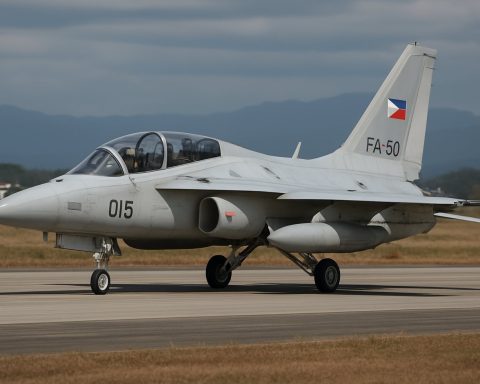- The Soyuz MS-27 rocket launched from Kazakhstan, carrying a crew to the International Space Station (ISS).
- The crew consists of Russian cosmonauts Sergei Ryzhikov and Alexei Zubritsky, alongside NASA astronaut Jonathan Kim.
- This mission highlights international cooperation in space exploration amid current geopolitical climates.
- The ISS, located 408 kilometers above Earth, serves both as a center for scientific study and a symbol of international unity.
- The mission carries experiments to advance understanding in microgravity effects on biology, chemistry, and physics, crucial for future deep space missions.
- The voyage reflects humanity’s enduring curiosity and the collaborative spirit that transcends terrestrial borders.
- The mission demonstrates technological achievement and the universal aspiration to explore the cosmos together.
- Ultimately, it underscores the transformative power of unity in turning space exploration dreams into reality.
https://youtube.com/watch?v=wYE20OfPUE8
A symphony of propulsion echoed across the arid plains of Kazakhstan as a Russian Soyuz rocket arced into the sky, carrying with it the hopes and dreams of Earthbound beings yearning for the stars. The Baikonur Cosmodrome, a hallowed ground for space exploration aficionados, witnessed its latest conquest: the Soyuz MS-27 spacecraft, hurtling towards the International Space Station (ISS) with precision and purpose.
On board this metallic bastion of international cooperation was a trio of intrepid travelers. Veterans of the cosmos, Russian cosmonauts Sergei Ryzhikov and Alexei Zubritsky were joined by NASA astronaut Jonathan Kim. Kim, a newcomer to the heavens but no stranger to missions of significance, lends a new chapter to a story of alliances transcending terrestrial borders. Together, they embody an emblem of what humanity can achieve when nations collaborate in pursuit of knowledge.
The International Space Station, an orbiting laboratory 408 kilometers above our planet, is set to receive its new inhabitants at precisely 0904 GMT. A marvel of international engineering, the ISS functions as both a sanctuary for scientific discovery and a symbol of what mankind can accomplish together.
Each voyage to the ISS is not merely a logistical maneuver or a scientific expedition; it is a testament to the endurance of human curiosity and the collaborative spirit that binds disparate nations with a singular goal. This partnership, perhaps even more significant in the context of current geopolitical climates, represents a beacon of unity in an age where borders on land often seem more palpable than ever.
As the spacecraft pierced through the final barriers of Earth’s atmosphere, it carried with it experiments meant to unlock the mysteries of life in microgravity, probing questions that tether deeply into our understanding of biology, chemistry, and physics. The onboard crew will continue ongoing studies, including research into how spaceflight affects the human body—knowledge that is crucial for the future of manned missions deeper into the cosmos.
Imagining the weightlessness that now cradles the crew, one is reminded of the poetic duality of space travel: it is as much an internal journey as it is an external exploration. Plunged into the intimate odyssey of the infinite, Ryzhikov, Zubritsky, and Kim not only engage in scientific pursuits but participate in a profound narrative that calls into question our place in the universe.
The Soyuz MS-27’s voyage signifies more than just technological prowess; it underscores a universal desire to reach for the stars, collaborate beyond political lines, and advance human understanding. This mission, like the ones before it and those yet to come, encourages us all to consider what we can achieve together, fortified by both the mysteries of the universe and the certainties of human perseverance.
As the world watches this testament to international cooperation, the ultimate reminder remains clear: in our vast universe, it is our unity that transforms dreams of space into tangible realities, allowing us to transcend the bounds of Earth and, in doing so, glimpse the boundless possibilities of human innovation.
Unveiling the Hidden Dynamics of a Historic Space Journey
Introduction
A Russian Soyuz rocket has once again drawn the world’s gaze to the enigmatic skies over Kazakhstan, propelling the Soyuz MS-27 spacecraft towards the International Space Station (ISS). This mission, echoing with the symphony of ambition and collaboration, marks an inspiring chapter in the saga of space exploration. Veteran cosmonauts Sergei Ryzhikov, Alexei Zubritsky, and NASA astronaut Jonathan Kim, the crew of this expedition, embody a journey that reaches beyond national borders and into the vast expanse of unknown celestial realms.
Exploring the Unknown: The Importance of the Soyuz MS-27 Mission
1. Scientific Objectives: The primary goal of the Soyuz MS-27 mission is to advance our understanding of life in microgravity. This includes experiments on the effects of prolonged space travel on the human body—crucial data for planning future deep-space missions. Research areas include muscle atrophy prevention, bone density loss mitigation, and studying changes in the cardiovascular system.
2. Technological Advancements: The success of the Soyuz missions is built on reliability. The spacecraft’s design has undergone multiple iterations, ensuring safety and efficiency. This includes modernized communication systems, improved docking capabilities, and enhanced life-support systems, making it a robust carrier for astronauts.
3. Geopolitical Significance: Amidst fluctuating global political landscapes, the ISS serves as a neutral zone where collaboration trumps conflict. It reinforces a commitment to peace and shared goals, proving that scientific pursuit can transcend geopolitical tensions.
Real-World Use Cases and Impacts
– Medical Innovations: Insights gained from studying human physiology in space have led to breakthroughs in medical technologies, such as MRI advancements and improved rehabilitation techniques for muscle-related conditions.
– Earth Observation: The ISS provides invaluable data for climate research, helping monitor deforestation, glacier melt, and sea-level changes. This contributes to better-informed environmental policies.
Current Industry Trends and Future Forecasts
– Commercialization of Space: The partnership between Russia, NASA, and others is a precursor to the growing trend of commercial space travel. Companies like SpaceX and Blue Origin are expected to provide regular flights to the ISS, democratizing access to space.
– Bridging Nations through Space Alliances: The mission underscores the importance of maintaining and expanding international coalitions in space exploration. Future partnerships may involve additional countries, further diversifying scientific input and innovation.
Pros & Cons Overview
– Pros:
– Promotes scientific advancement through international collaboration.
– Provides practical data applicable to healthcare and environmental science.
– Inspires future generations in STEM fields.
– Cons:
– High costs associated with space missions can strain budgets.
– Political tensions may impede operational efficiency and collaboration.
– Space debris accumulation poses potential risks for future missions.
Practical Tips and Recommendations
– Utilize collaborations and partnerships to foster innovation and reduce costs in scientific research and space exploration.
– Advocate for policies that prioritize peaceful scientific endeavors over political disputes in space exploration forums.
– Encourage educational programs that highlight space missions to inspire young minds globally.
Helpful Link: For continuous updates and information on international space collaborations, you can visit NASA.
In conclusion, the launch of the Soyuz MS-27 is more than a milestone; it’s a beacon of hope and a reminder of humanity’s capacity for innovation and cooperation. As we look to the stars, let us harness this unity to propel us toward a future where the possibilities are as limitless as space itself.







